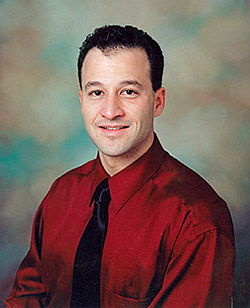New NIH Network Revolutionizes Stroke Clinical Research
UC San Diego Health System fights stroke as key center for nationwide effort
By:
- Jackie Carr
Published Date
By:
- Jackie Carr
Share This:
Article Content

Brett C. Meyer, MD, vascular neurologist, co-director of the UCSD Stroke Center and medical director of UC San Diego Health System Enterprise Telemedicine.
A network of 25 nationally recognized stroke centers has been created to rapidly address the three core features of stroke research and care: prevention, treatment and recovery. The regional coordinating centers (RCCs), working with nearby satellite facilities, will span the country and have teams of researchers representing every stroke-related medical specialty, with the primary goal of bringing new therapies and strategies to the stroke community more rapidly. The centers, which include UC San Diego Health System as a grant recipient, were announced yesterday by the National Institutes of Health.
“The new system is intended to streamline stroke research, by centralizing approval and review, lessening time and costs of clinical trials, and assembling a comprehensive data sharing system,” said Petra Kaufmann, MD, associate director for clinical research at the National Institute of Neurological Disorders and Stroke (NINDS).
NINDS, which will fund and manage the NIH Stroke Trials Network, or NIH StrokeNet, has a strong history of successful stroke clinical trials over the past 40 years, leading to critical advances in treatment and prevention of the disease, including the first treatment for acute stroke in 1995, the rt-PA clot-buster.
UC San Diego Health System and its health partners were integral to the rt-PA approval and numerous other stroke developments such as using hypothermia for stroke, telemedicine for rt-PA decision-making, novel endovascular approaches for clot removal and new neuroprotective approaches. In 2012, UC San Diego Health System had one of the first five facilities in the country to be certified as a Comprehensive Stroke Center (CSC), the newest level of certification for advanced stroke care awarded by The Joint Commission.
The new StrokeNet program will enable novel and critical research to be performed at a more rapid and collaborative pace since it encourages other San Diego health care systems to collaborate as partners with UC San Diego Health System.
"NIH Stroke Net has enabled UC San Diego to partner with the ‘best of the best’ in our California clinical community to provide cutting-edge stroke clinical trial opportunities to as many community members as possible, irrespective of geographical location,” said Brett C. Meyer, MD, vascular neurologist, co-director of the UCSD Stroke Center and medical director of UC San Diego Health System Enterprise Telemedicine.
The 25 centers were developed to be strategically placed in every region of the country. Successful applicants have demonstrated experience in stroke research and recruitment, including the ability to enroll underrepresented populations, and are required to offer access to the full cadre of stroke-care specialties including emergency medicine, neurosurgery, interventional neuroradiology, vascular neurology, neurointensive care, neuroimaging, stroke rehabilitation and pediatric neurology.
Historically, the model for stroke clinical trials was to develop large teams of personnel and infrastructure where trials were to be implemented, which were then disassembled once the trial was completed. This led to delays in patient recruitment and additional costs when new trials were initiated.
The network concept evolved from an NINDS planning effort in which stroke experts were asked what is most needed to reduce death and disability due to stroke in the United States. They called for a nationwide stroke network that would allow for a more seamless transition between early safety and efficacy trials and Phase II and III clinical trials. This network model of Regional Coordinating Centers, partnering with extremely capable satellite health care facilities and systems, will leverage coordinated care, contracting, and research approvals in order to enable enrollment of patients into novel stroke trials.
“A long-standing NIH mission has been to enable more persons to be offered access to these types of stroke trial opportunities,” said Meyer. “Now, in true partnership with many of the outstanding stroke care facilities throughout our region, we can do just that – provide best clinical and research care to this network for acute stroke, stroke prevention, and stroke recovery. UC San Diego looks forward to coordinating this universal aim, and working with these hospitals and systems.”
A stroke occurs when blood flow to the brain is interrupted, causing brain cells in the immediate area to die because they stop getting oxygen. Stroke can also occur when a vessel breaks and bleeds into the brain. The number of new strokes reported each year is 795,000, making stroke the fourth leading cause of death in the US. Because stroke is age-linked the incidence is expected to rise rapidly in the next decade. NINDS is the nation’s leading funder of research on the brain and nervous system. For more information about stroke, please visit: http://stroke.nih.gov
The study was funded by the following NINDS grants: (centers) 1U10NS086497-01; 1U10NS086489-01; 1U10NS086513-01; 1U10NS086729-011U10NS086512-01; 1U10NS086607-01; 1U10NS086492-01; 1U10NS086467-01; 1U10NS086494-01; 1U10NS086608-01; 1U10NS086484-01; 1U10NS086728-01; 1U10NS086521-01; 1U10NS086606-01; 1U10NS086496-01; 1U10NS086526-01; 1U10NS086487-01; 1U10NS086535-01; 1U10NS086474-01; 1U10NS086528-01; 1U10NS086531-01; 1U10NS086533-01; 1U10NS086490-01; 1U10NS086525-01; (clinical coordinating center) 1U01 NS086872-01.
Share This:
Stay in the Know
Keep up with all the latest from UC San Diego. Subscribe to the newsletter today.



